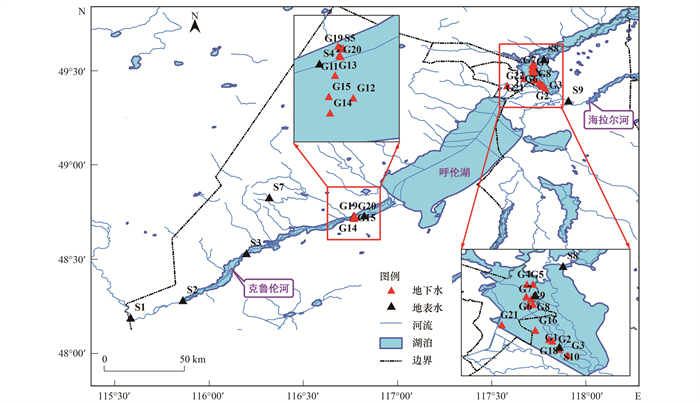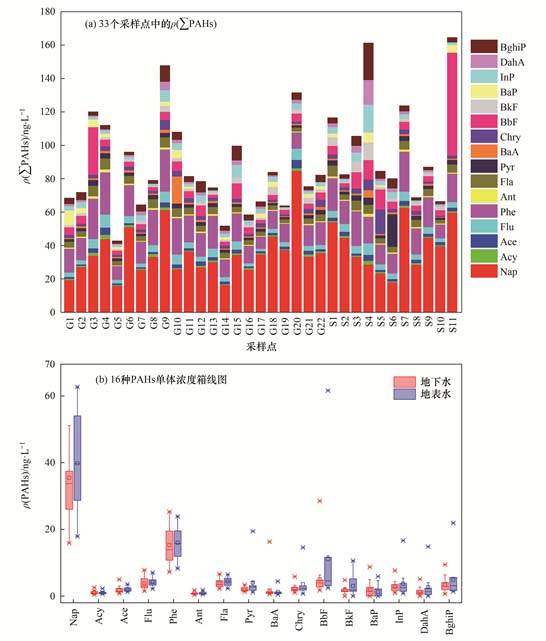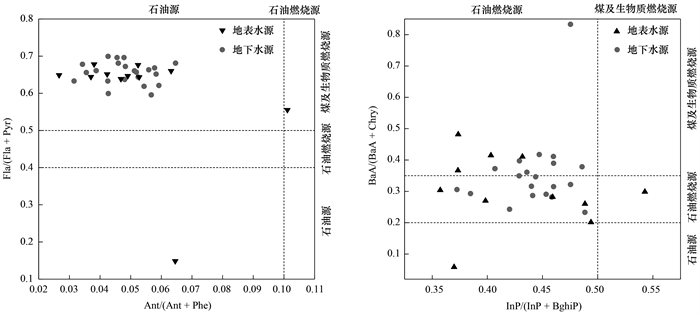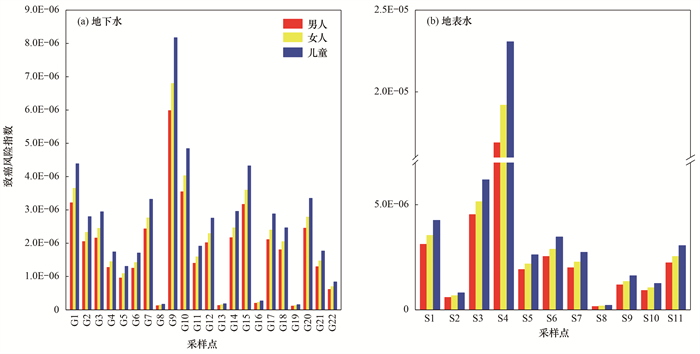2. 中国环境科学研究院湖泊水污染治理与生态修复技术国家工程实验室, 北京 100012;
3. 东北林业大学林学院, 哈尔滨 150040
 PAHs)检出范围为42.76~164.50 ng ·L-1, 平均值为90.82 ng ·L-1, 其中地表水和地下水中ρ(
PAHs)检出范围为42.76~164.50 ng ·L-1, 平均值为90.82 ng ·L-1, 其中地表水和地下水中ρ( PAHs)检出范围分别为66.39~164.50 ng ·L-1和42.76~147.70 ng ·L-1.检出的PAHs单体ρ(萘)最大, 平均值达36.91 ng ·L-1, ρ(蒽)最小, 仅为0.81 ng ·L-1, 其中地下水与地表水采样点中各PAHs单体检出浓度没有明显差异(P>0.05). PAHs的污染处于国内外中等水平, 主要以中低环为主(3~4环).采用比值特征法和主成分分析法对研究区域地下水和地表水中PAHs的来源进行解析表明, 研究区域饮用水源水体中PAHs主要受到煤及生物质燃烧和石油燃烧的影响, 部分地表水源水体受到石油源的影响.健康和生态风险评估结果表明, 饮用水源地水体不会对人体造成健康风险, 生态风险处于中等水平, 但其中苯并[b]荧蒽(BbF)单体产生风险较高应引起持续地关注, 从饮用水源地的可持续发展与饮水安全角度出发, 应考虑采取必要监管与保护措施以防止进一步的污染.结果为饮用水源地PAHs的污染治理与防控提供了科学依据.
PAHs)检出范围分别为66.39~164.50 ng ·L-1和42.76~147.70 ng ·L-1.检出的PAHs单体ρ(萘)最大, 平均值达36.91 ng ·L-1, ρ(蒽)最小, 仅为0.81 ng ·L-1, 其中地下水与地表水采样点中各PAHs单体检出浓度没有明显差异(P>0.05). PAHs的污染处于国内外中等水平, 主要以中低环为主(3~4环).采用比值特征法和主成分分析法对研究区域地下水和地表水中PAHs的来源进行解析表明, 研究区域饮用水源水体中PAHs主要受到煤及生物质燃烧和石油燃烧的影响, 部分地表水源水体受到石油源的影响.健康和生态风险评估结果表明, 饮用水源地水体不会对人体造成健康风险, 生态风险处于中等水平, 但其中苯并[b]荧蒽(BbF)单体产生风险较高应引起持续地关注, 从饮用水源地的可持续发展与饮水安全角度出发, 应考虑采取必要监管与保护措施以防止进一步的污染.结果为饮用水源地PAHs的污染治理与防控提供了科学依据.
2. National Engineering Laboratory for Lake Pollution Control and Ecological Restoration, Chinese Research Academy of Environmental Sciences, Beijing 100012, China;
3. College of Forestry, Northeast Forestry University, Harbin 150040, China
 PAHs) was 42.76-164.50 ng·L-1, and the mean value was 90.82 ng·L-1. The detection ranges of ρ(
PAHs) was 42.76-164.50 ng·L-1, and the mean value was 90.82 ng·L-1. The detection ranges of ρ( PAHs) in surface water and groundwater were 66.39-164.50 ng·L-1 and 42.76-147.70 ng·L-1, respectively. The concentration of the detected naphthalene was the highest, with a mean value of 36.91 ng·L-1, and the concentration of anthracene was the lowest, with a mean value of 0.81 ng·L-1; there were no significant differences among the concentrations of all the PAHs monomers of the surface and groundwater (P > 0.05). The pollution of PAHs was at a median level in China and abroad, mainly in the middle and low loops (3-4 loops). The analysis of the sources of PAHs in groundwater and surface water in Manzhouli using the ratio feature method and principal component analysis showed that the PAHs in the drinking water source water bodies in the Manzhouli area were mainly affected by the combustion of coal and biomass and oil, and some surface water sources were affected by the oil source. The human health and ecological risk assessment results showed that the water body of drinking water would not cause health risks to the human body, and the ecological risk was at a medium level; however, the high risk of benzo [b] fluoranthene (BbF) monomer production should be continuous cause for concern. From the perspective of the sustainable development of drinking water sources and drinking water safety, the necessary supervision and protection measures should be considered to prevent further pollution. The results of this research provide a scientific basis for the pollution control and prevention and control of PAHs in drinking water sources.
PAHs) in surface water and groundwater were 66.39-164.50 ng·L-1 and 42.76-147.70 ng·L-1, respectively. The concentration of the detected naphthalene was the highest, with a mean value of 36.91 ng·L-1, and the concentration of anthracene was the lowest, with a mean value of 0.81 ng·L-1; there were no significant differences among the concentrations of all the PAHs monomers of the surface and groundwater (P > 0.05). The pollution of PAHs was at a median level in China and abroad, mainly in the middle and low loops (3-4 loops). The analysis of the sources of PAHs in groundwater and surface water in Manzhouli using the ratio feature method and principal component analysis showed that the PAHs in the drinking water source water bodies in the Manzhouli area were mainly affected by the combustion of coal and biomass and oil, and some surface water sources were affected by the oil source. The human health and ecological risk assessment results showed that the water body of drinking water would not cause health risks to the human body, and the ecological risk was at a medium level; however, the high risk of benzo [b] fluoranthene (BbF) monomer production should be continuous cause for concern. From the perspective of the sustainable development of drinking water sources and drinking water safety, the necessary supervision and protection measures should be considered to prevent further pollution. The results of this research provide a scientific basis for the pollution control and prevention and control of PAHs in drinking water sources.
多环芳烃(polycyclic aromatic hydrocarbons, PAHs)是一类在环境中普遍存在的持久性有机污染物[1].因其具有疏水性、热稳定性和生物累积效应而使其在环境中持续存在, 进而对人体健康和生态环境造成严重风险[2]. PAHs化合物具有潜在的毒性、诱变性和致癌性[3, 4], 因此美国环境保护局(US EPA)已经宣布将16种PAHs单体列为优先控制的环境污染物[5].环境中的PAHs来源主要有森林火灾、火山喷发和生物内源合成等的自然排放以及化石燃料、有机材料和工业排放等的人为排放.当前, 与其他持久性有机污染物(其中大多数在世界范围内已被禁止)不同, 环境中的PAHs是由于工业过程、农业废物、汽车尾气、煤炭燃烧和石化产品排放等人类活动从初级来源释放的, 人为排放的PAHs最终通过大气沉降、雨水冲刷和地表径流的方式源源不断地进入各种环境介质中, 特别是流域水环境.目前已有研究表明, 在我国的七大流域(长江、黄河、海河、松花江、珠江、淮河、辽河)[6]、美国[7]、加拿大[8]和澳大利亚[9]等世界范围的水库、湖泊和河流地表水及地下水中均有不同程度的PAHs检出.其中, 地下水作为全球淡水的主要来源, 占地球可用淡水总量的97%, 其余3%主要是地表水[10].因此, 地下水在世界许多地区均被认为是最重要的公共供水来源[11].
满洲里和新右旗位于内蒙古自治区东北部, 由于地理位置、气候、降水量和水系等因素导致其水资源短缺, 周边居民的生产生活用水主要依靠傍河浅层地下水和流经该地区的克鲁伦河及海拉尔河两大流域的地表水源[12, 13].近年来有关流域中有机物的污染研究逐渐增多, 但有关满洲里和新右旗两个地区饮用水源中PAHs的污染还未见相关报道, PAHs在饮用水源地的污染会对生态和人体健康造成严重的危害.通过对这两地区不同类型饮用水源中PAHs的分布特征、污染来源和风险进行综合研究, 以期为水源地污染控制和流域水资源及生态的可持续发展提供重要的科学依据.
1 材料与方法 1.1 试剂与仪器本研究采用固相萃取-气相色谱-质谱(SPE-GC-MS)法对满洲里饮用水源水体中16种优控多环芳烃进行了定性定量检测分析.主要试剂: 系列标准物质购自美国Wellington公司, 具体见表 1; HLB(6 mL, 500 mg, 美国Waters)SPE固相萃取小柱; 农残级CH2Cl2和色谱纯级CH3OH(购自美国Merck); 测定时所选用的替代物为萘-d8、
|
|
表 1 饮用水源水体PAHs检测单体物质 Table 1 Same lineage of PAHs was detected in the drinking water sources |
1.2 样品采集与处理
本研究选择内蒙古东北部的满洲里与新右旗地区, 根据满洲里和新右旗地区饮用水源地分布及关联地表水体的地理区位情况, 本研究于2020年8月在呼伦贝尔市的满洲里和新右旗地区地下饮用水(水井)及海拉尔河和克鲁伦河流域地表水源选取了共33个采样点位(见图 1), 其中包含地表水体采样点11个(编号为S1~S11)和地下水体采样点22个(编号为G1~G22).每个采样点采集3个平行样品(地表水采自水面下0.5m水深处), 采集后的水样放置于预先准备好的用丙酮清洗过的棕色玻璃瓶中, 放置于装有冰块的保温箱中, 最后尽快运送至4℃的冰箱中保存并在24 h内处理.

|
图 1 饮用水源地水体采样点示意 Fig. 1 Sample sites of the drinking water sources |
水样的预处理方法参考之前所做的研究[14], 具体步骤如下: ①首先将1 L水样通过0.45 μm滤膜过滤.②将固相萃取小柱与12孔的萃取装置连接, 然后依次用6 mL的二氯甲烷和甲醇对萃取小柱进行活化, 期间固相萃取小柱不要流干, 然后再用6 mL的超纯水对小柱进行活化和淋洗各一次, 以备上样.③在水样中加入10 ng替代物后进行固相萃取, 处理后的水样通过活化后的HLB小柱, 同时使用真空泵抽滤, 控制溶液流速在5 mL ·min-1, 待水样滴完后, 继续抽滤0.5 h.④用10 mL CH2Cl2洗脱样品后用旋转蒸发仪和氮吹仪将其浓缩至0.5 mL, 最后加入十氯联苯内标物后进行GC-MS分析.分析时所用GC-MS仪器分析条件参考文献[15].
1.3 质量控制在样品分析前, 初始精密度和回收率的测定方法如下: 在样品的制备和提取等处理步骤中均采用3个平行的水样, 在每批10个样品中增加1个方法空白, 方法空白中目标化合物均未检出(未达到检出限).对多环芳烃样品分别添加萘-d8、
采用SPE-GC-MS对研究区域地下及地表饮用水源水体中PAHs进行定量检测, 
|
|
表 2 饮用水水源中PAHs检出情况1) Table 2 Concentrations of the detected of PAHs in the drinking water sources |
从检出浓度来看, 研究区域饮用水源地水体中ρ(



|
图 2 饮用水源水体中PAHs浓度 Fig. 2 Concentrations of detected PAHs in the drinking water sources |
此外, 由图 2(a)可以看出, 在研究区域饮用水源33个点位中, 地表水中的S11点位处ρ(




图 3揭示了饮用水源地地表和地下饮用水源中PAHs的组成.从中可以看出地表和地下水源水体中PAHs均以3~4环为主, 在地表水和地下水中的占比分别为60.00% ~69.23%和56.25% ~68.46%, 由此可知饮用水源地地下和地表饮用水中PAHs的组成相似, 这些结果与以往的研究相似[17, 18].这可能是因为与高分子量(high molecular weight, HMW)的PAHs相比, 低分子量(low molecular weight, LMW)的PAHs具有更强的水溶性, 相反由于HMW的PAHs辛醇-水的分配系数高且具有疏水性, 导致HMW的PAHs更容易在沉积物中沉积[19].因此, 随着时间的推移, 水中的HMW化合物最终会转移到沉积物中[20].然而, 本研究中高分子量(5~6环)的PAHs占比稍高(23.25% ~28.33%), 这可能与近期排放中HMW的PAHs的存在有关[21].

|
(a)地表水, (b)地下水 图 3 饮用水源水体中各种环数PAHs占比 Fig. 3 Proportion of PAHs content of different ring numbers in the drinking water sources |
国内外典型河流、湖泊和水库地表水及部分地下水中PAHs的检出情况汇总见表 3.研究区域饮用水源地地表水体中PAHs的检出范围为55.39~164.50 ng ·L-1, 略低于国内武汉长江饮用水源地(57.04~475.79 ng ·L-1)、上海城市河网(46.53~221.54 ng ·L-1)和长三角饮用水源地(4.25~407.00 ng ·L-1), 远低于国外埃及尼罗河(1 112.70~4 364.30 ng ·L-1).污染水平与国外美国密西西比河(22.20~163.40 ng ·L-1)、国内三峡水库水体(3.90~107.60 ng ·L-1)和国内于桥水库(13.70~104.10 ng ·L-1)相当.但是研究区域PAHs浓度高于国内三峡水库支流(1.92~40.33 ng ·L-1)和国外加拿大Athabasca区地表水(ND~91.90 ng ·L-1).地下水方面, 研究区域饮用水源地地下水检出浓度低于国内的滹沱河冲洪积扇地下水(ND~333.40 ng ·L-1)、黄河口地下水(8.51~402.86 ng ·L-1)和柳州市地下水(105.87~854.47 ng ·L-1), 远低于国内太湖苏南地下水(4.00~32 449.00 ng ·L-1)和国外墨西哥梅里达城地下水(30.00~19 500.00 ng ·L-1).因此, 研究区域地表水饮用水源中PAHs的污染在国内外水体中处于中等水平, 高于部分饮水水源水体, 地下水饮水水源污染水平较低, 从保障饮水安全的角度出发, 应该关注相关污染, 以确保为公众提供优质饮用水.
|
|
表 3 国内外水体中PAHs的浓度1) Table 3 Concentration of PAHs in water bodies of China and abroad |
2.4 饮用水源水体中PAHs的来源解析 2.4.1 比值特征法源解析
环境中赋存的PAHs的来源比较复杂, 由于不同来源的PAHs在单体组成与含量具有差异, 本研究采用比值特征法来解析PAHs的来源[31, 32].鉴于低分子的PAHs单体稳定性较差, 已有研究中普遍采用Ant/(Ant+Phe)、BaA/(BaA+Chry)、Fla/(Fla+Pyr)和InP/(InP+BghiP)等稳定性较好的单体的比值(见表 4)来解析环境中PAHs的来源[33], 主要包括了石油源、石油燃烧源和煤及生物质燃烧源这3种人为源.由图 4可知, 饮水水源地下水和地表水中的PAHs均主要来自煤及生物质燃烧和石油燃烧, 另有部分地表水源水体中PAHs来源于石油源.由此可知, 石油源、石油燃烧源和煤及生物质燃烧源均对研究区域饮用水源水体中PAHs产生了影响.
|
|
表 4 PAHs的源解析比值 Table 4 Source resolution discrimination of PAHs |

|
图 4 饮用水源水体中PAHs来源解析 Fig. 4 Source analysis of PAHs in the drinking water sources |
为了进一步明确各种人为源的贡献率, 本研究使用SPSS经过方差极大标准化旋转后对研究区域地下和地表水源水体提取了特征值大于1的主成分, 其中在地下水和地表水中分别提取出了2种和3种主成分, 它们累积分别占数据集方差的86.746%和76.639%(表 5).在地下水源中, 第一主成分贡献率为72.715%, 它所表示的单体为Acy、Ace、Flu、Fla、Chry、Phe和Pyr, 其中Fla、Pyr、Chry和Phe表示煤炭等物质燃烧[34], Acy表示薪柴生物质燃烧源[35], 由此可认为第一主成分表示煤炭及木材的燃烧源; 第二主成分贡献率为14.031%, 表示Flu、Ant和BbF等物质, 其中BbF为交通石油燃烧排放源, Ant为煤燃烧源[36], 故认为第二主成分表示石化燃料的燃烧源.地表水源中3个主成分的累积方差贡献率为76.639%, 其中第一主成分表示Acy、Ace、Flu、Phe、Ant、Fla、BkF、InP、DahA和BghiP这10种单体, 其中BkF、DahA和BghiP表示交通排放源[37], Flu、Phe、Ant和Fla表示煤炭燃烧源, Acy和Ace表示木材生物质燃烧源; 第二主成分表示Nap和Phe, 其中Nap表示石油泄漏源[38, 39], Phe表示煤炭燃烧源; 第三主成分表示BaP单体, 表示交通排放源.两种源解析方式得出的结果均表明, 研究区域地下水和地表水水体中PAHs的污染均受到了煤及木材等生物质的燃烧和机动车石油燃烧排放的混合源污染, 部分地表水体还受到了石油泄漏产生的污染.
|
|
表 5 PAHs的主成分分析 Table 5 Principal component analysis of PAHs |
3 风险评价 3.1 健康风险评价
人体直接饮用摄入是饮用水源地水体中PAHs暴露的主要途径.终生致癌风险模型已经广泛应用在PAHs对各类人群的健康风险评估中[40, 14].由于本研究中16种优控PAHs单体并没有完整的毒性参数, 但各单体的毒性作用机制相似, 因此本研究引入了毒性当量因子TEF[41]来确定16种PAHs单体的毒性, 其中各化合物毒性当量因子见表 6.在此模型中, 将BaP设定为1, 其他15种PAHs单体的TEF值通过与等量BaP毒性比较大小而得出, PAHs的致癌风险指数(R)的计算见公式(1)和公式(2):

|
(1) |

|
(2) |
|
|
表 6 16种PAHs单体毒性当量因子 Table 6 Toxicity equivalent factors for 16 PAHs compound |
式中, IR为每日饮水摄入量(L ·d-1), 其取值参考文献[42~44], 成人和儿童分别取值1.85和1.00; TEQBaP为基于BaP的毒性当量浓度(mg ·L-1); EF为每年暴露天数(d ·a-1), 取值365; CSF为致癌斜率系数, 本研究取值为7.3 kg ·d ·mg-1[45]; ED为暴露时间, 成人男性和女性分别取值74 a和78 a, 儿童取值为12 a[46]; AT为时间, 由(ED×EF)计算可知男人、女人和儿童分别为27 010、28 470和4 380 d; BW为体重(kg), 本研究分别取值67.7、59.6和26.8; Ci为各单体PAHs在水中的检出浓度(mg ·L-1), 计算时按照地下水和地表水所对应浓度进行取值.
对研究区域饮用水源水体中PAHs进行健康风险评估, 结果如图 5所示.饮用水源水体中PAHs暴露对成年男性、成年女性和儿童所产生的致癌风险范围分别为1.13×10-7~1.69×10-5、1.28×10-7~1.92×10-5和1.54×10-7~2.31×10-5, 其中地下水平均致癌风险为2.15×10-6和3.83×10-6.根据US EPA定义, PAHs对人体的暴露风险均处于可接受范围内(10-6~10-4), 但是仍然超过了风险阈值(10-6).值得注意的是, 儿童的风险高于成人, 这与之前的研究结果一致[14, 47].这可能是由于儿童更容易受到污染物的危害.进一步说明为了更好地保障饮水健康与水生态安全, 确需进行全面的污染物分布与毒性学特性调查.

|
图 5 饮用水源地PAHs健康风险评估 Fig. 5 Health risk assessment of PAHs in drinking water sources |
本研究采用风险熵值(RQ)法[45]对饮用水源水体进行生态风险评价, 并将所检出的16种优控PAHs单体均纳入评价范围.通过水体中检出PAHs单体的质量浓度与其质量的比值来计算RQ值, 具体见公式(3):

|
(3) |
式中, cPAHs为样品中各PAHs单体的浓度(ng ·L-1), 计算时分别取各单体在地下水和地表水中的平均浓度; cQV为各单体所对应的风险值(ng ·L-1); 通常在研究中采用PAHs的最低风险标准浓度值cQV-NCs(ng ·L-1)和最大允许浓度值cQV-MPCs(ng ·L-1)来计算风险熵值, 具体见公式(4)和公式(5):

|
(4) |

|
(5) |
式中, RQNCs和RQMPCs分别为最小和最大生态风险熵值.值得注意的是, 由于生态风险评价的RQ熵值法只适用萘(Nap)、芴(Flu)、菲(Phe)、蒽(Ant)、苯并[a]蒽(BaA)、
由表 7可以看出, 研究区域地下水饮用水源中16种PAHs单体的风险熵值RQMPCs均小于1, 除

|
|
表 7 地下和地表饮用水源中PAHs的生态风险熵值 Table 7 Ecological risk assessment of PAHs in the underground and surface drinking water sources |
4 结论
(1) 研究区域饮用水源水体中16种PAHs单体均被检出, 且以中低环(3~4)为主, ρ(

(2) 比值特征法和主成分分析法结果表明, 研究区域饮用水源水体中PAHs是以石油燃烧源和煤及生物质燃烧源为主的混合源, 部分地表水源水体存在石油源.
(3) 健康风险评估显示, 饮用水源地水体中PAHs暴露不会对人体产生健康危害, 但是儿童暴露风险高于成人; 生态风险评估显示, 生态风险处于中等水平, 但其中苯并[b]荧蒽(BbF)单体产生风险较高应引起持续地关注, 从饮用水源地的生态可持续发展与饮水安全角度出发, 应考虑采取必要措施以防止进一步地污染.
| [1] |
李慧, 李捷, 宋鹏, 等. 东北小兴凯湖沉积物POPs污染特征及生态风险评价[J]. 环境科学, 2021, 42(1): 147-158. Li H, Li J, Song P, et al. Characteristics and ecological risk assessment of POPs pollution in sediments of Xiaoxingkai Lake in the northeast China[J]. Environmental Science, 2021, 42(1): 147-158. |
| [2] | Tian Y Z, Li W H, Shi G L, et al. Relationships between PAHs and PCBs, and quantitative source apportionment of PAHs toxicity in sediments from Fenhe reservoir and watershed[J]. Journal of Hazardous Materials, 2013, 248-249: 89-96. DOI:10.1016/j.jhazmat.2012.12.054 |
| [3] | Chen J, Fan B, Li J, et al. Development of human health ambient water quality criteria of 12 polycyclic aromatic hydrocarbons (PAH) and risk assessment in China[J]. Chemosphere, 2020, 252. DOI:10.1016/j.chemosphere.2020.126590 |
| [4] | Samanta S K, Singh O V, Jain R K, et al. Polycyclic aromatic hydrocarbons: environmental pollution and bioremediation[J]. Trends in Biotechnology, 2002, 20(6): 243-248. DOI:10.1016/S0167-7799(02)01943-1 |
| [5] | Manoli E, Samara C, Konstantinou I, et al. Polycyclic aromatic hydrocarbons in the bulk precipitation and surface waters of Northern Greece[J]. Chemosphere, 2000, 41(12): 1845-1855. DOI:10.1016/S0045-6535(00)00134-X |
| [6] |
范博, 王晓南, 黄云, 等. 我国七大流域水体多环芳烃的分布特征及风险评价[J]. 环境科学, 2019, 40(5): 2101-2114. Fan B, Wang X N, Huang Y, et al. Distribution and risk assessment of polycyclic aromatic hydrocarbons in water bodies in seven basins of China[J]. Environmental Science, 2019, 40(5): 2101-2114. |
| [7] | Zhang S Y, Zhang Q, Darisaw S, et al. Simultaneous quantification of polycyclic aromatic hydrocarbons (PAHs), polychlorinated biphenyls (PCBs), and pharmaceuticals and personal care products (PPCPs) in Mississippi River water, in New Orleans, Louisiana, USA[J]. Chemosphere, 2007, 66(6): 1057-1069. DOI:10.1016/j.chemosphere.2006.06.067 |
| [8] | Birks S J, Cho S, Taylor E, et al. Characterizing the PAHs in surface waters and snow in the Athabasca region: implications for identifying hydrological pathways of atmospheric deposition[J]. Science of the Total Environment, 2017, 603-604: 570-583. DOI:10.1016/j.scitotenv.2017.06.051 |
| [9] | Shaw M, Tibbetts I R, Müller J F. Monitoring PAHs in the Brisbane River and Moreton Bay, Australia, using semipermeable membrane devices and EROD activity in yellowfin bream, Acanthopagrus australis[J]. Chemosphere, 2004, 56(3): 237-246. DOI:10.1016/j.chemosphere.2004.03.003 |
| [10] | Jurado A, Walther M, Díaz-Cruz M S. Occurrence, fate and environmental risk assessment of the organic microcontaminants included in the Watch Lists set by EU Decisions 2015/495 and 2018/840 in the groundwater of Spain[J]. Science of the Total Environment, 2019, 663: 285-296. DOI:10.1016/j.scitotenv.2019.01.270 |
| [11] | Szekeres E, Chiriac C M, Baricz A, et al. Investigating antibiotics, antibiotic resistance genes, and microbial contaminants in groundwater in relation to the proximity of urban areas[J]. Environmental Pollution, 2018, 236: 734-744. DOI:10.1016/j.envpol.2018.01.107 |
| [12] |
张坤锋, 昌盛, 赵少延, 等. 克鲁伦河流域地下水饮用水水源中挥发性有机物的污染特征与风险评价[J]. 环境工程技术学报, 2021, 11(6): 1083-1091. Zhang K F, Chang S, Zhao S Y, et al. Pollution characteristics and risk assessment of volatile organic compounds in groundwater drinking water sources in Klulun River Basin[J]. Journal of Environmental Engineering Technology, 2021, 11(6): 1083-1091. |
| [13] |
张坤锋, 赵少延, 孙兴滨, 等. 海拉尔河及傍河地下水饮用水源中挥发性有机物的污染特征与风险[J]. 河南师范大学学报(自然科学版), 2021, 49(5): 74-82. Zhang K F, Zhao S Y, Sun X B, et al. Pollution characteristics and risks of volatile organic compounds in drinking water sources of Hailar River and nearby rivers groundwater[J]. Journal of Henan Normal University (Natural Science Edition), 2021, 49(5): 74-82. |
| [14] |
张坤锋, 付青, 涂响, 等. 武汉典型饮用水水源中典型POPs污染特征与健康风险评估[J]. 环境科学, 2021, 42(12): 5836-5847. Zhang K F, Fu Q, Tu X, et al. Pollution characteristics and risk assessment of typical POPs in typical drinking water sources in Wuhan[J]. Environmental Science, 2021, 42(12): 5836-5847. |
| [15] |
昌盛, 赵兴茹, 付青, 等. 输水期间于桥水库流域水体中溶解态多环芳烃的分布特征与风险[J]. 环境科学, 2016, 37(7): 2530-2538. Chang S, Zhao X R, Fu Q, et al. Distribution characteristics and risk assessment of polycyclic aromatic hydrocarbons in the water of Yuqiao Reservoir watershed during the water delivery period[J]. Environmental Science, 2016, 37(7): 2530-2538. |
| [16] | Li J, Li F D, Liu Q. PAHs behavior in surface water and groundwater of the Yellow River estuary: evidence from isotopes and hydrochemistry[J]. Chemosphere, 2017, 178: 143-153. DOI:10.1016/j.chemosphere.2017.03.052 |
| [17] |
蓝家程, 孙玉川, 田萍, 等. 岩溶地下河流域水中多环芳烃污染特征及生态风险评价[J]. 环境科学, 2014, 35(10): 3722-3730. Lan J C, Sun Y C, Tian P, et al. Contamination and ecological risk assessment of polycyclic aromatic hydrocarbons in water and in karst underground river catchment[J]. Environmental Science, 2014, 35(10): 3722-3730. |
| [18] | Liu J, Qi S H, Yao J, et al. Contamination characteristics of organochlorine pesticides in multimatrix sampling of the Hanjiang River Basin, southeast China[J]. Chemosphere, 2016, 163: 35-43. DOI:10.1016/j.chemosphere.2016.07.040 |
| [19] | Liu C Y, Huang Z F, Qadeer A, et al. The sediment-water diffusion and risk assessment of PAHs in different types of drinking water sources in the Yangtze River Delta, China[J]. Journal of Cleaner Production, 2021, 309. DOI:10.1016/j.jclepro.2021.127456 |
| [20] | Dachs J, Méjanelle L. Organic pollutants in coastal waters, sediments, and biota: a relevant driver for ecosystems during the anthropocene?[J]. Estuaries and Coasts, 2010, 33(1): 1-14. DOI:10.1007/s12237-009-9255-8 |
| [21] | Zheng B H, Wang L P, Lei K, et al. Distribution and ecological risk assessment of polycyclic aromatic hydrocarbons in water, suspended particulate matter and sediment from Daliao River estuary and the adjacent area, China[J]. Chemosphere, 2016, 149: 91-100. DOI:10.1016/j.chemosphere.2016.01.039 |
| [22] | Zheng B H, Ma Y Q, Qin Y W, et al. Distribution, sources, and risk assessment of polycyclic aromatic hydrocarbons (PAHs) in surface water in industrial affected areas of the Three Gorges Reservoir, China[J]. Environmental Science and Pollution Research, 2016, 23(23): 23485-23495. DOI:10.1007/s11356-016-7524-1 |
| [23] | Liu S, Liu X R, Liu M, et al. Levels, sources and risk assessment of PAHs in multi-phases from urbanized river network system in Shanghai[J]. Environmental Pollution, 2016, 219: 555-567. DOI:10.1016/j.envpol.2016.06.010 |
| [24] |
林莉, 董磊, 李青云, 等. 三峡库区水体和底泥中多环芳烃和邻苯二甲酸酯类分布和来源[J]. 湖泊科学, 2018, 30(3): 660-667. Lin L, Dong L, Li Q Y, et al. Distribution and sources of polycyclic aromatic hydrocarbons and phthalic acid esters in water and surface sediment from the Three Gorges Reservoir[J]. Journal of Lake Sciences, 2018, 30(3): 660-667. |
| [25] | Sharma B M, Melymuk L, Bharat G K, et al. Spatial gradients of polycyclic aromatic hydrocarbons (PAHs) in air, atmospheric deposition, and surface water of the Ganges River basin[J]. Science of the Total Environment, 2018, 627: 1495-1504. DOI:10.1016/j.scitotenv.2018.01.262 |
| [26] | Badawy M I, Embaby M A. Distribution of polycyclic aromatic hydrocarbons in drinking water in Egypt[J]. Desalination, 2010, 251(1-3): 34-40. DOI:10.1016/j.desal.2009.09.148 |
| [27] |
昌盛, 耿梦娇, 刘琰, 等. 滹沱河冲洪积扇地下水中多环芳烃的污染特征[J]. 中国环境科学, 2016, 36(7): 2058-2066. Chang S, Geng M J, Liu Y, et al. Pollution characteristic of polycyclic aromatic hydrocarbons in the groundwater of Hutuo River pluvial fan[J]. China Environmental Science, 2016, 36(7): 2058-2066. DOI:10.3969/j.issn.1000-6923.2016.07.022 |
| [28] |
苗迎, 孔祥胜, 李成展. 重工业城市岩溶地下水中多环芳烃污染特征及来源[J]. 环境科学, 2019, 40(1): 239-247. Miao Y, Kong X S, Li C Z. Distribution and sources of polycyclic aromatic hydrocarbons in a Karst groundwater system in a strongly industrial city[J]. Environmental Science, 2019, 40(1): 239-247. |
| [29] |
崔学慧, 李炳华, 陈鸿汉. 太湖平原城近郊区浅层地下水中多环芳烃污染特征及污染源分析[J]. 环境科学, 2008, 29(7): 1806-1810. Cui X H, Li B H, Chen H H. Contamination characteristics and pollutant sources analysis on PAHs in shallow groundwater in suburb of Taihu Plain[J]. Environmental Science, 2008, 29(7): 1806-1810. DOI:10.3321/j.issn:0250-3301.2008.07.008 |
| [30] | López-Macias R, Cobos-Gasca V, Cabañas-Vargas D, et al. Presence and spatial distribution of polynuclear aromatic hydrocarbons (PAHs) in groundwater of Merida City, Yucatan, Mexico[J]. Bulletin of Environmental Contamination and Toxicology, 2019, 102(4): 538-543. DOI:10.1007/s00128-019-02580-7 |
| [31] | Yang H H, Lee W J, Chen S J, et al. PAH emission from various industrial stacks[J]. Journal of Hazardous Materials, 1998, 60(2): 159-174. DOI:10.1016/S0304-3894(98)00089-2 |
| [32] | Zhang L F, Dong L, Ren L J, et al. Concentration and source identification of polycyclic aromatic hydrocarbons and phthalic acid esters in the surface water of the Yangtze River Delta, China[J]. Journal of Environmental Sciences, 2012, 24(2): 335-342. DOI:10.1016/S1001-0742(11)60782-1 |
| [33] |
贾天琪, 雷荣荣, 武小琳, 等. 长江下游支流水体中多环芳烃的分布及生态风险评估[J]. 环境科学, 2020, 41(5): 2221-2228. Jia T Q, Lei R R, Wu X L, et al. Distribution, sources, and risk assessment of polycyclic aromatic hydrocarbons (PAHs) in tributary waters of the lower reaches of the Yangtze River, China[J]. Environmental Science, 2020, 41(5): 2221-2228. |
| [34] |
周婕成, 陈振楼, 毕春娟, 等. 温州城市河流中多环芳烃的污染特征及其来源[J]. 环境科学, 2012, 33(12): 4226-4236. Zhou J C, Chen Z L, Bi C J, et al. Pollution characteristics and sources of polycyclic aromatic hydrocarbons in urban rivers of Wenzhou City[J]. Environmental Science, 2012, 33(12): 4226-4236. |
| [35] | Masclet P, Cachier H, Liousse C, et al. Emissions of polycyclic aromatic hydrocarbons by savanna fires[J]. Journal of Atmospheric Chemistry, 1995, 22(1-2): 41-54. DOI:10.1007/BF00708180 |
| [36] | Sofowote U M, McCarry B E, Marvin C H. Source apportionment of PAH in Hamilton Harbour suspended sediments: comparison of two factor analysis methods[J]. Environmental Science & Technology, 2008, 42(16): 6007-6014. |
| [37] |
葛蔚, 程琪琪, 柴超, 等. 山东省农田土壤多环芳烃的污染特征及源解析[J]. 环境科学, 2017, 38(4): 1587-1596. Ge W, Cheng Q Q, Chai C, et al. Pollution characteristics and source analysis of polycyclic aromatic hydrocarbons in agricultural soils from Shandong[J]. Environmental Science, 2017, 38(4): 1587-1596. |
| [38] | Dobbins R A, Fletcher R A, Benner Jr B A, et al. Polycyclic aromatic hydrocarbons in flames, in diesel fuels, and in diesel emissions[J]. Combustion and Flame, 2006, 144(4): 773-781. DOI:10.1016/j.combustflame.2005.09.008 |
| [39] | Miao Y, Kong X S, Li C X. Distribution, sources, and toxicity assessment of polycyclic aromatic hydrocarbons in surface soils of a heavy industrial city, Liuzhou, China[J]. Environmental Monitoring and Assessment, 2018, 190(3): 164. DOI:10.1007/s10661-018-6521-x |
| [40] |
张家泉, 胡天鹏, 邢新丽, 等. 大冶湖表层沉积物-水中多环芳烃的分布、来源及风险评价[J]. 环境科学, 2017, 38(1): 170-179. Zhang J Q, Hu T P, Xing X L, et al. Distribution, sources and risk assessment of the PAHs in the surface sediments and water from the Daye Lake[J]. Environmental Science, 2017, 38(1): 170-179. DOI:10.3969/j.issn.1673-288X.2017.01.052 |
| [41] | Nisbet I C T, LaGoy P K. Toxic equivalency factors (TEFs) for polycyclic aromatic hydrocarbons (PAHs)[J]. Regulatory Toxicology and Pharmacology, 1992, 16(3): 290-300. DOI:10.1016/0273-2300(92)90009-X |
| [42] | 赵秀阁, 段小丽. 中国人群暴露参数手册(成人卷): 概要[M]. 北京: 中国环境出版社, 2014. |
| [43] | 环境保护部. 中国人群暴露参数手册(儿童卷: 6~17岁)[M]. 北京: 中国环境出版社, 2016. |
| [44] |
张坤锋, 昌盛, 涂响, 等. 新冠疫情下武汉典型饮用水水源中DBPs污染特征与风险评估[J]. 环境科学, 2022, 43(2): 878-886. Zhang K F, Chang S, Tu X, et al. Pollution characteristics and risk assessment of DBPs in typical drinking water sources in Wuhan under the COVID-19[J]. Environmental Science, 2022, 43(2): 878-886. DOI:10.3969/j.issn.1000-6923.2022.02.042 |
| [45] | Meng Y, Liu X H, Lu S Y, et al. A review on occurrence and risk of polycyclic aromatic hydrocarbons (PAHs) in lakes of China[J]. Science of the Total Environment, 2019, 651: 2497-2506. DOI:10.1016/j.scitotenv.2018.10.162 |
| [46] | 中国统计年鉴. 中国国家统计局按地区划分的人口预期寿命[EB/OL]. http://www.Stats.Gov.cn/tjsj/ndsj/yb2004-c/indexch.htm, 2021-09-30. |
| [47] | Shi W, Zhang F X, Zhang X W, et al. Identification of trace organic pollutants in freshwater sources in eastern China and estimation of their associated human health risks[J]. Ecotoxicology, 2011, 20(5): 1099-1106. |
| [48] | Kalf D F, Crommentuijn T, van de Plassche E J. Environmental quality objectives for 10 polycyclic aromatic hydrocarbons (PAHs)[J]. Ecotoxicology and Environmental Safety, 1997, 36(1): 89-97. |
 2022, Vol. 43
2022, Vol. 43


